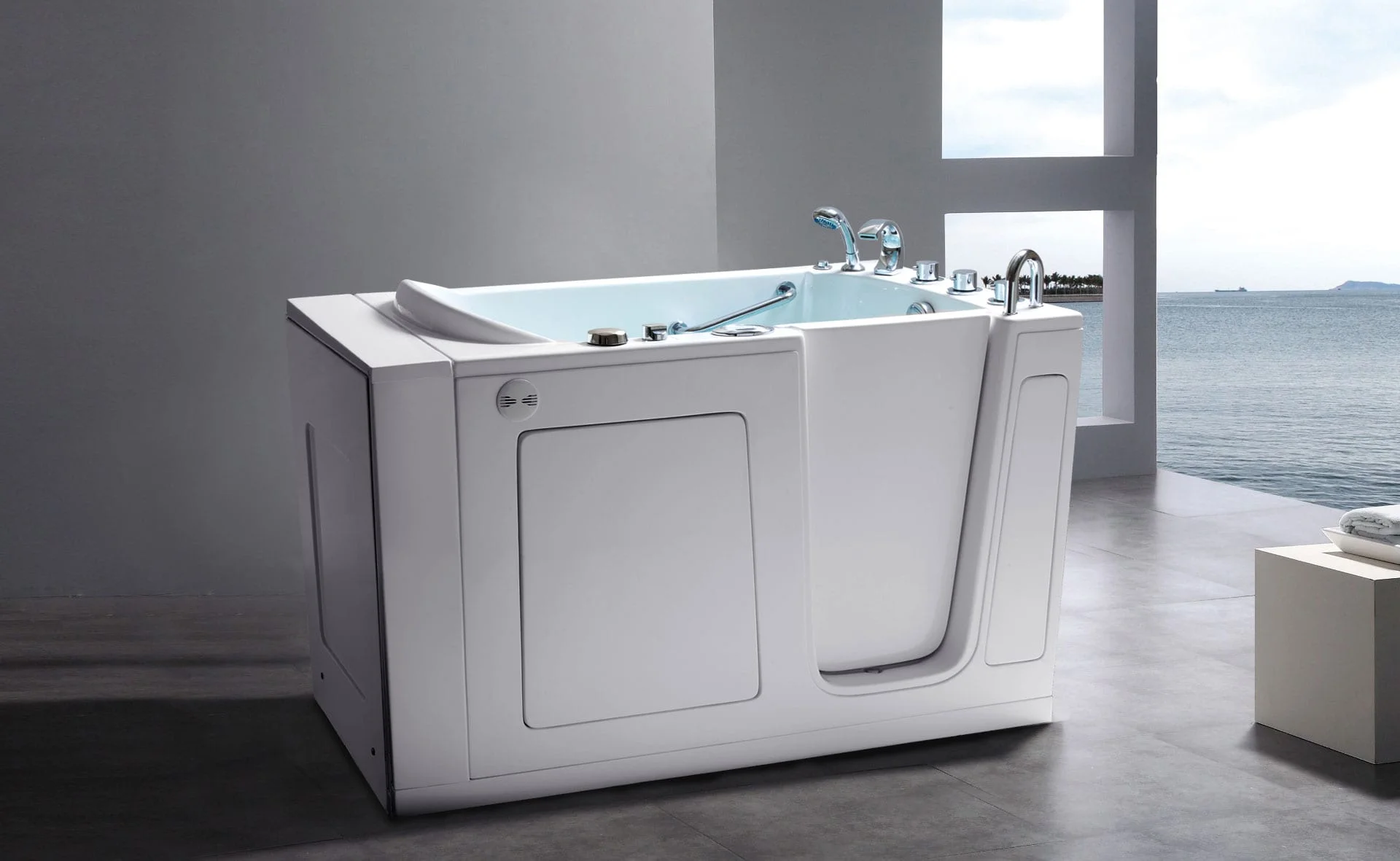The bathroom remains one of the most dangerous rooms in any home especially for the elderly, with slippery surfaces and high tub walls creating serious fall risks that can result in life-changing injuries. Walk-in tubs promise to address these safety concerns while providing therapeutic benefits, but they also come with significant costs and certain limitations that deserve careful consideration.
This comprehensive guide examines the value of walk-in tubs for your specific situation. We’ll explore who benefits most from these specialized bathing fixtures, what features they typically include, and how they compare to alternative safety solutions. By weighing the advantages against the drawbacks and reviewing all available options, you can make an informed decision about how a walk-in tub aligns with your safety needs, budget, and long-term goals for independent living.
Walk-In Tubs: Essential Bathroom Safety Solutions
Walk-in tubs are specially designed bathing fixtures that provide a safer, more accessible bathing experience for individuals facing mobility challenges, physical disabilities, or age-related limitations. These therapeutic bathing solutions feature a watertight door that allows users to walk directly into the tub rather than stepping over a high threshold, eliminating one of the most dangerous aspects of traditional bathing that contributes to thousands of bathroom falls each year.
These innovative fixtures primarily serve seniors and the handicapped who face increased fall risks when navigating standard bathtubs, but their benefits extend far beyond age-related concerns. Bathroom falls represent a significant portion of home accidents among older adults, with the combination of wet surfaces, hard fixtures, and high step-overs creating particularly hazardous conditions. Individuals with arthritis, joint pain, or limited mobility find relief from the struggle of stepping over high tub walls, while people recovering from surgery or injury can maintain their bathing independence during healing periods. Those with balance issues, wheelchair users, and individuals relying on walkers or other mobility aids discover that walk-in tubs transform bathing from a dangerous challenge into a manageable daily routine.
Standard walk-in tub features focus on both safety and comfort to address the specific needs of their users. Built-in grab bars provide essential stability during entry, exit, and movement within the tub, while textured, non-slip flooring significantly reduces fall risks. Comfortable built-in seating eliminates the need to lower oneself to the tub bottom, and quick-drain systems minimize the waiting time after bathing when users might feel cold or uncomfortable. Many models enhance the experience with therapeutic elements such as air jets for gentle massage, water jets for muscle relief, or chromotherapy lighting for relaxation and mood enhancement.
The importance of walk-in tubs extends far beyond their practical features to the fundamental human need for dignity and independence in personal care. For many individuals who have reluctantly given up regular bathing due to safety fears or physical limitations, these tubs restore not just cleanliness but confidence and quality of life. The therapeutic benefits including improved circulation, reduced joint pain, and muscle relaxation provide genuine health advantages that can complement medical treatments. Perhaps most significantly, walk-in tubs enable aging adults to remain safely in their own homes longer by addressing bathroom safety concerns that often drive difficult decisions about assisted living or nursing home placement.
Pros and Cons of Walk-in Tubs
Below are the main pros and cons to help you see how this option may fit your home and needs:
Pros of Walk-in Tubs
Walk-in tubs significantly improve bathroom safety by eliminating the high step-over barrier that causes many falls in traditional bathtubs. The low threshold entry, typically 3-7 inches compared to 14-16 inches for standard tubs, makes bathing accessible for individuals with mobility limitations, arthritis, or balance issues. Built-in safety features like grab bars, non-slip surfaces, and comfortable seating provide additional security and confidence during bathing.
Many walk-in tubs offer therapeutic benefits through hydrotherapy jets, heated surfaces, and aromatherapy systems that can help reduce joint pain, improve circulation, and provide muscle relaxation. These features make the tubs particularly valuable for individuals managing chronic pain conditions or recovering from injuries. The ability to bathe independently often restores dignity and quality of life for users who may have previously required assistance or avoided bathing altogether.
Walk-in tubs can potentially increase home value and make properties more attractive to aging-in-place buyers. They also eliminate the need for costly bathroom modifications or the expense of assisted living facilities for some individuals who can maintain independence with this single safety upgrade.
Cons of Walk-in Tubs
The most significant drawback is the requirement to wait for the tub to fill before entering and drain completely before exiting, which can take 6-15 minutes depending on the model and water pressure. This waiting period can be uncomfortable, especially for individuals who get cold easily or have bladder control issues.
Walk-in tubs typically cost significantly more than standard tubs, with prices ranging from $3,000 to $15,000 or more, plus installation costs that may require plumbing modifications. Insurance rarely covers these expenses, making them a substantial out-of-pocket investment for many families.
Installation often requires professional plumbing work and may necessitate bathroom renovations to accommodate the tub’s size and requirements. Some models are larger than standard tubs, potentially reducing bathroom floor space. Additionally, walk-in tubs use more water than showers, increasing utility costs, and the door seals require regular maintenance to prevent leaks over time.
Alternatives to Walk-In Tubs
Several alternatives exist for individuals seeking safer bathing solutions, each with distinct advantages and limitations compared to walk-in tubs.
Shower conversions eliminate the step-over barrier and provide easier access at lower costs than walk-in tubs. Roll-in showers with zero-threshold entries accommodate wheelchairs effectively and offer faster entry and exit. However, shower conversions eliminate the therapeutic soaking benefits that many individuals find helpful for joint pain and circulation, along with the relaxation that comes with warm baths.
Installing grab bars, shower seats, non-slip mats, and raised toilet seats represents the most affordable approach to bathroom safety improvements. These modifications cost hundreds rather than thousands of dollars and can reduce fall risks significantly. However, they don’t address the fundamental challenge of stepping over high tub walls, and individuals with severe mobility limitations may still find traditional tubs dangerous.
Transfer benches allow users to sit and slide into tubs, while mechanical bath lifts lower individuals into the water and raise them out. These solutions cost less than walk-in tubs and work with existing bathrooms. However, they require upper body strength and coordination that some individuals lack, and bath lifts need regular maintenance and eventual replacement.
Portable walk-in tub inserts create a walk-in door within existing tubs at significantly lower costs with minimal modification required. However, they typically don’t provide the same level of safety features, therapeutic options, or structural integrity as purpose-built walk-in tubs.
Why Walk-In Tubs Are the Best Option
Walk-in tubs represent the superior choice for individuals with serious mobility challenges because they maintain therapeutic soaking benefits while providing comprehensive safety solutions. Unlike shower conversions, walk-in tubs offer the pain relief and circulation improvement that medical professionals often recommend for arthritis and other conditions.
Walk-in tubs provide exceptional wheelchair accessibility through low-threshold design and built-in transfer capabilities. Many models feature seats positioned at wheelchair height, making transfers easier than navigating traditional tubs or shower systems. The door design eliminates the need to lift legs over barriers while grab bars provide transfer stability.
The integrated safety elements surpass what alternatives can offer. Built-in seating eliminates slipping risks when sitting down, textured flooring provides wet traction, and the enclosed design prevents water spillage that creates external slip hazards. Quick-drain systems minimize time spent in cold conditions, with emergency drain features for urgent situations.
Walk-in tubs enable long-term bathing independence better than any alternative solution. While grab bars and transfer benches may work temporarily, progressive mobility decline often makes these inadequate over time. Walk-in tubs accommodate changing needs and serve users effectively even as physical capabilities diminish, potentially delaying or eliminating the need for assisted living arrangements. The initial investment often proves more cost-effective than repeated modifications or eventual professional care services.
FAQs: Walk-In Bathtubs
Our most frequently asked questions when talking to homeowners about the benefits of walk-in tubs:
How much do walk-in tubs typically cost?
Walk-in tubs typically cost between $7,000 and $35,000 including installation, with basic models starting around $2,000 for the unit and luxury options reaching $20,000 or more. Installation adds $1,000 to $20,000 depending on required modifications, and most insurance plans don’t cover these expenses.
Are walk-in tubs safe for seniors?
Walk-in tubs are generally very safe for seniors and significantly reduce fall risks compared to traditional bathtubs through low step-in thresholds, grab bars, and non-slip surfaces. However, seniors must be able to wait for filling and draining cycles and operate the door mechanism safely.
Do walk-in tubs require a lot of maintenance?
Walk-in tubs require moderate maintenance, primarily focusing on keeping door seals clean and properly functioning to prevent leaks. Regular cleaning of jets and drain systems is needed for models with hydrotherapy features, and periodic inspection of grab bars and hardware ensures continued safety, but overall maintenance requirements are comparable to standard bathtubs with some additional attention to sealing mechanisms.
Can walk-in tubs help with mobility issues?
Walk-in tubs can significantly help with mobility issues by providing low-threshold entry, built-in seating, and grab bars that make bathing safer and more accessible for individuals with arthritis, balance problems, or limited mobility. The therapeutic features like warm water soaking and hydrotherapy jets may help reduce joint stiffness and muscle pain, though they cannot cure underlying mobility conditions and should complement, not replace, medical treatment and physical therapy.
Contact Us for Your Walk-In Tub Installation
We partner with American Tubs to provide walk-in tubs built for durability and daily use. Their construction focuses on the safety features and reliability that matter most when mobility limitations make standard bathtubs dangerous.
American Tubs models include the safety elements you need: slip-resistant flooring, grab bars positioned for stability, and built-in seating that eliminates the risks of lowering yourself into a traditional tub. You can add therapeutic features like hydrotherapy jets if those benefits align with your health goals and budget.
Ready to make bathing safer and more manageable? Contact us today at 844-DaBella today for your free consultation. Our team will evaluate your bathroom space, discuss your specific mobility needs, and recommend the American Tubs model that provides the best solution for your situation. We handle the complete installation process to ensure your new walk-in tub functions properly from day one.

